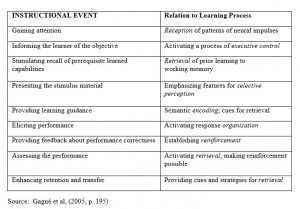The following is a reflection on Week 2 of the Learning Theories module using Gibbs Reflective Cycle.
Description
We covered both the Behaviourist and Cognitive Theories in class this week.
Behaviourism
Behaviourism defines learning as a change in behaviour where there is association between stimulus and response. I was relatively comfortable with the behaviourist theory and could relate to elements of it in my own work due to the competency skill nature of my work e.g. computer training.
The behaviourist theorists we discussed were: Pavlov, Thorndike, Watson, Skinner, Bandura. However, it can be argued that their work is predominately based on animals and children. Repetition is distinct in the behaviourism approach with imitation as noted by Bandura. I can relate to this in my own classroom as I demonstrate to the students and expect them to imitate my actions using repetition. It is a teacher-centered approach. This is I would use Gagné’s Nine Events of Instruction (see below) for my work and see elements of both behaviourism and cognitivism in it. However, I am looking forward to learning more about constructivism next week as I feel it may be very relevant to my work.

Cognitivism
While behaviourists ignore what goes on in the brain cognitivists do not. As noted by Jen in our lecture today cognitivism views that ‘learners organise and interpret information to create knowledge’. This is in contrast to behaviourism where the learners are passive. The main challenge is moving information from the short term memory to the long term memory.
We looked at Baddeley’s Enhancing Working Memory:
- Repeat, rephrase it
- Emphasise relevance
- Practice, try out, Visualise it
- Teach it
(Source: Jen Harvey Class Notes)
We also looked at Sweller’s Cognitive Load Theory and Bartlett’s schemas. Schemas are our representations of information which can change and most importantly have an impact on new information we receive.
Feelings
I can relate very strongly to the behaviourist theory and feel that while it has many positive traits I need to be more open and consider other theories that my enhance my teaching.
Evaluation
The class today consisted of a very informative lecture with some good visual videos. Even though I was aware of both theories considering that adults return to education expecting a behaviourist approach was interesting. I particularly liked the video from The Big Bang Theory which captured positive reinforcement in Skinner’s operant conditioning.
We were each asked to share our definition of learning and below is the selection of individual post it notes with everyone’s definition. Knowledge was a keyword in most of the definitions and it was interesting to view other people’s perspectives and the similarities.

Definition of Learning – My image
Analysis
Behaviourism is an effective method for teaching computers but is it effective for the theoretical elements of computers. For example, lecturing students on computer theory alone is not sufficient. How are they to take responsibility of their own learning?
Cognitivism is a theory which I gave little attention to, however, on reflection, it is fundamental in education. In my opinion, many learners simply learn information to regurgitate for an exam without fully understanding what they have learned. As a result they will forget this information in the long term. As a result I favour assignments and projects as the students engage with the subject and as a result learn more.
The following are implications as set out by Jen in her presentation which I feel are important learning points I have taken away from this theory.
Cognitivism – Implications for Teaching
- Prior knowledge can lead to interference, distortion and enhancement of memory (Bartlett, 1932)
- For meaningful learning, information needs to be organised in logical hierarchal structures (scaffolding knowledge, Vygotsky etc)
- Important to try and tap into learner’s existing schemas to link new information to existing knowledge (Advance organisers, Ausubel)
- Helpful to use diagnostic methods to identify where students are, link information together eg concept mapping tools
- Try not to introduce too much information at one time so that learner has time to process information and create new links
(Source: Jen Harvey Class Notes)
Conclusion
Behaviourism is related to change in behaviour and is teacher-centred where students are passive learners. Cognitivism on the other hand takes the brain into consideration including schemas so that new information can be linked to what they already know. It is important to introduce information to learners in small chunks. Behaviourism is suitable for competency based skills and cognitivism is suitable for theoretical content.
Action Plan
It is important that I continue to immerse myself in this new knowledge and reflect on how I can adapt relevant theories to my practice. Furthermore, I am looking forward to learning more about constructivism next week as I feel it may be very relevant to my work.